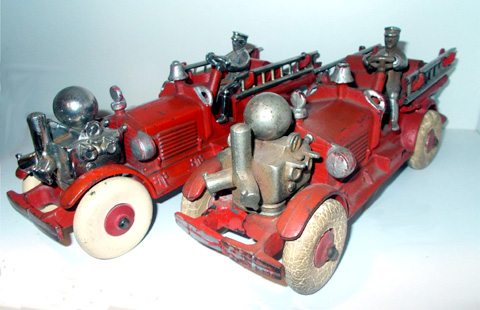By Roy Blomster

I am a toy collector. I have been collecting since the mid-1970s, and as a member of the ATCA, I enjoy going all over the country viewing other people’s collections. Most of the collections date prior to 1941–a year that was to become a major turning point for toys because the metal and lead used in their production was needed to build the weapons for World War II. Many of the toys produced before the war were never to be made again, and by the time the war ended, new, more streamlined methods of manufacturing and the introduction of plastics changed the toy industry.
I am also an artist. I use metal in creating my artwork, and as such, have been fortunate in being able to find broken metal toys that I have been able to repair. Although time-consuming and labor-intensive, making a careful repair is another way to acquire more toys if one is fortunate enough to possess the skills required.
Some time back, my friend Bob, a fellow collector, dangled a broken cast-iron Ahrens Fox Pumper in front of me. Even though the toy was broken, I practically drooled over it. It was made in the 1930s by the Hubley Company, known for making cast-iron toys. Bob asked me to restore the toy. Even though cast iron appears to be strong, in reality, if dropped it can be as fragile as glass. It’s also difficult to re-join cast iron pieces and when people resort to epoxy, it results in only a temporary fix as the joint will ultimately come unglued. Bob’s toy was missing both ends of the simulated hoses at the rear of the toy and the right front bumper was completely broken off. Restoring these parts would not be easy and also meant borrowing a complete toy to use as a model. I estimated it would require about 100 hours to fashion all the missing parts by hand and to then reattach them.
You cannot weld cast iron. After the missing pieces are made, a special, small torch and silver solder is required to attach the new pieces to the toy. When joining the pieces, it is important to not disturb the color of the original toy in any way. Whenever a toy is repainted, even with a touch-up, it can affect the value of the toy. This makes the task of matching new paint to the patina of old paint possibly the most frustrating part of the repair. The patina of the toy Bob dangled in front of me had taken 50 years to acquire its look. When Bob asked how much to repair the toy, I responded, “$500. “Then I asked him, “How much do you want for the toy? Bob said, “$500. “I am sure Bob must have known I would be ripe for the picking, and I was.
To me, toys are not just toys. They are little works of art and icons of the past. I recall vividly the Ahrens Fox pumper at the fire station on Tower Hill in Lynn, Massachusetts, near where I lived. It was a sight to behold with its glistening chrome ball contrasted against the red of the fire engine. The firemen always sat in front of the little fire station with the doors open almost as if they were showing off the chrome ball on their polished Ahrens Fox pumper gleaming just inside the doorway. The whole image projected shapes and colors as good as any abstract modern sculpture.
Repairing the fire engine was long and difficult. It required borrowing a good Ahrens Fox pumper to use as a model to get the parts correct. There are not many collectors who have the Ahrens Fox pumper, much less one who would be willing to lend it to be used to pattern a copy. The only way I was able to get one was to barter–I agreed to repair a toy for another collector in exchange for borrowing the pumper.
It had always been my intention to upgrade my Ahrens Fox pumper and then sell my repaired one. Recently, a Fox came up at auction and the opportunity to upgrade became a reality. All I had to do was be willing to spend the money. The toy in the auction looked all shiny and new. I knew it had some replaced ladders and chrome parts so I was sure it would not fetch top dollar. I was right and won the toy at auction for $1000. My grand idea was to take the worn figure and aged chrome parts from my repaired piece and place them on the newly acquired toy. Then I would put the newer looking parts on my repaired toy and try to sell it. That is, the idea seemed good until the newly acquired toy arrived. I put them side-by-side and realized right away when I saw the two toys together that I had too much invested in my repaired toy to part with itÑand I don’t mean money. My Ahrens Fox pumper has a history with a story that means more to me than the money.
